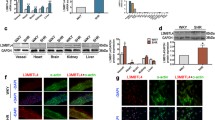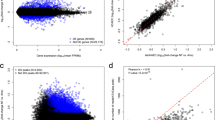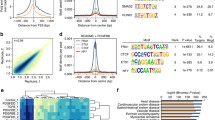Abstract
The mechanisms underlying coronary microvascular remodeling and dysfunction, which are critical determinants of abnormal myocardial blood flow regulation in human hypertension, are poorly understood. The spontaneously hypertensive rat (SHR) exhibits many features of human hypertensive cardiomyopathy. We demonstrate that remodeling of intramural coronary arterioles is apparent in the SHR already at 4 weeks of age, i.e. before the onset of systemic hypertension. To uncover possible genetic determinants of coronary microvascular remodeling, we carried out detailed histological and histomorphometric analysis of the heart and coronary vasculature in 30 weeks old SHR, age-matched Brown Norway (BN-Lx) parentals and BXH/HXB recombinant inbred (RI) strains. Using previously mapped expression quantitative trait loci (eQTLs), we carried out a genome-wide association analysis between genetic determinants of cardiac gene expression and histomorphometric traits. This identified 36 robustly mapped eQTLs in the heart which were associated with medial area of intramural coronary arterioles [false discovery rate (FDR) ~5 %]. Transcripts, which were both under cis-acting genetic regulation and significantly correlated with medial area (FDR <5 %), but not with blood pressure indices, were prioritized and four candidate genes were identified (Rtel1, Pla2g5, Dnaja4 and Rcn2) according to their expression levels and biological functions. Our results demonstrate that genetic factors play a role in the development of coronary microvascular remodeling and suggest blood pressure independent candidate genes for further functional experiments.





Similar content being viewed by others
References
Aitman TJ, Glazier AM, Wallace CA, Cooper LD, Norsworthy PJ, Wahid FN, Al-Majali KM, Trembling PM, Mann CJ, Shoulders CC, Graf D, St Lezin E, Kurtz TW, Kren V, Pravenec M, Ibrahimi A, Abumrad NA, Stanton LW, Scott J (1999) Identification of Cd36 (Fat) as an insulin-resistance gene causing defective fatty acid and glucose metabolism in hypertensive rats. Nat Genet 21:76–83. doi:10.1038/5013
Atanur SS, Birol I, Guryev V, Hirst M, Hummel O, Morrissey C, Behmoaras J, Fernandez-Suarez XM, Johnson MD, McLaren WM, Patone G, Petretto E, Plessy C, Rockland KS, Rockland C, Saar K, Zhao Y, Carninci P, Flicek P, Kurtz T, Cuppen E, Pravenec M, Hubner N, Jones SJ, Birney E, Aitman TJ (2010) The genome sequence of the spontaneously hypertensive rat: analysis and functional significance. Genome Res 20:791–803. doi:10.1101/gr.103499.109
Berwick ZC, Moberly SP, Kohr MC, Morrical EB, Kurian MM, Dick GM, Tune JD (2012) (2012) Contribution of voltage-dependent K+ and Ca2+ channels to coronary pressure-flow autoregulation. Basic Res Cardiol 107:264. doi:10.1007/s00395-012-0264-6
Boyanovsky B, Zack M, Forrest K, Webb NR (2009) The capacity of group V sPLA2 to increase atherogenicity of ApoE−/− and LDLR−/− mouse LDL in vitro predicts its atherogenic role in vivo. Arterioscler Thromb Vasc Biol 29:532–538. doi:10.1161/ATVBAHA.108.183038
Brilla CG, Janicki JS, Weber KT (1991) Impaired diastolic function and coronary reserve in genetic hypertension. Role of interstitial fibrosis and medial thickening of intramyocardial coronary arteries. Circ Res 69:107–115
Camici PG, Crea F (2007) Coronary microvascular dysfunction. N Engl J Med 356:830–840. doi:10.1056/NEJMra061889
Clozel JP, Kuhn H, Hefti F (1989) Decreases of vascular hypertrophy in four different types of arteries in spontaneously hypertensive rats. Am J Med 87:92S–95S. doi:10.1016/0002-9343(89)90102-2
Desjardins JF, Pourdjabbar A, Quan A, Leong-Poi H, Teichert-Kuliszewska K, Verma S, Parker TG (2009) Lack of S100A1 in mice confers a gender-dependent hypertensive phenotype and increased mortality after myocardial infarction. Am J Physiol Heart Circ Physiol 296(5):H1457–H1465
Dickhout JG, Lee RM (1997) Structural and functional analysis of small arteries from young spontaneously hypertensive rats. Hypertension 29:781–789
Hegmann JP, Possidente B (1981) Estimating genetic correlations from inbred strains. Behav Genet 11:103–114
Heusch G (2010) Adenosine and maximum coronary vasodilation in humans: myth and misconceptions in the assessment of coronary reserve. Basic Res Cardiol 105:1–5. doi:10.1007/s00395-009-0074-7
Honoré B (2009) The rapidly expanding CREC protein family: members, localization, function, and role in disease. BioEssays 31:262–277. doi:10.1002/bies.200800186
Hubner N, Wallace CA, Zimdahl H, Petretto E, Schulz H, Maciver F, Mueller M, Hummel O, Monti J, Zidek V, Musilova A, Kren V, Causton H, Game L, Born G, Schmidt S, Müller A, Cook SA, Kurtz TW, Whittaker J, Pravenec M, Aitman TJ (2005) Integrated transcriptional profiling and linkage analysis for identification of genes underlying disease. Nat Genet 37:243–253. doi:10.1038/ng1522
Jacobsen JC, Mulvany MJ, Holstein-Rathlou NH (2008) A mechanism for arteriolar remodeling based on maintenance of smooth muscle cell activation. Am J Physiol Regul Integr Comp Physiol 294:R1379–R1389. doi:10.1152/ajpregu.00407.2007
Katz PS, Trask AJ, Souza-Smith FM, Hutchinson KR, Galantowicz ML, Lord KC, Stewart JA Jr, Cismowski MJ, Varner KJ, Lucchesi PA (2011) Coronary arterioles in type 2 diabetic (db/db) mice undergo a distinct pattern of remodeling associated with decreased vessel stiffness. Basic Res Cardiol 106(6):1123–1134. doi:10.1007/s00395-011-0201-0
Knaapen P, Camici PG, Marques KM, Nijveldt R, Bax JJ, Westerhof N, Götte MJ, Jerosch-Herold M, Schelbert HR, Lammertsma AA, van Rossum AC (2009) Coronary microvascular resistance: methods for its quantification in humans. Basic Res Cardiol 104:485–498. doi:10.1007/s00395-009-0037-z
Kunes J, Dobesova Z, Musilova A, Zidek V, Vorlicek J, Pravenec M, Kren V, Zicha J (2008) Hemodynamic characterization of recombinant inbred strains: twenty years later. Hypertens Res 31:1659–1668
Kuo L, Chilian WM, Davis MJ (1990) Coronary arteriolar myogenic response is independent of endothelium. Circ Res 66:860–866
Lambeau G, Gelb MH (2008) Biochemistry and physiology of mammalian secreted phospholipases A2. Annu Rev Biochem 77:495–520. doi:10.1146/annurev.biochem.76.062405.154007
Liu Y, Gutterman DD (2009) Vascular control in humans: focus on the coronary microcirculation. Basic Res Cardiol 104:211–227. doi:10.1007/s00395-009-0775-y
Ludvigsen M, Jacobsen C, Maunsbach AB, Honoré B (2009) Identification and characterization of novel ERC-55 interacting proteins: evidence for the existence of several ERC-55 splicing variants; including the cytosolic ERC-55-C. Proteomics 9:5267–5287. doi:10.1002/pmic.200900321
Lupi A, Buffon A, Finocchiaro ML, Conti E, Maseri A, Crea F (1997) Mechanisms of adenosine-induced epicardial coronary artery dilatation. Eur Heart J 18:614–617
Manichaikul A, Wang Q, Shi YL, Zhang Z, Leitinger N, Shi W (2011) Characterization of Ath29, a major mouse atherosclerosis susceptibility locus, and identification of Rcn2 as a novel regulator of cytokine expression. Am J Physiol Heart Circ Physiol 301:H1056–H1061. doi:10.1152/ajpheart.00366.2011
Maron MS, Olivotto I, Maron BJ, Prasad SK, Cecchi F, Udelson JE, Camici PG (2009) The case for myocardial ischemia in hypertrophic cardiomyopathy. J Am Coll Cardiol 54:866–875. doi:10.1016/j.jacc.2009.04.072
Motz W, Strauer BE (1994) Therapy of hypertensive cardiac hypertrophy and impaired coronary microcirculation. J Cardiovasc Pharmacol 24(Suppl 1):S34–S38. doi:10.1097/00005344-199424001-00007
Mulvany MJ (1999) Vascular remodelling of resistance vessels: can we define this? Cardiovasc Res 41:9–13. doi:10.1016/S0008-6363(98)00289-2
Neglia D, Fommei E, Varela-Carver A, Mancini M, Ghione S, Lombardi M, Pisani P, Parker H, D’amati G, Donato L, Camici PG (2011) Perindopril and indapamide reverse coronary microvascular remodelling and improve flow in arterial hypertension. J Hypertens 29:364–372. doi:10.1097/HJH.0b013e328340a08e
Nickerson MM, Song J, Meisner JK, Bajikar S, Burke CW, Shuptrine CW, Owens GK, Skalak TC, Price RJ (2009) Bone marrow-derived cell-specific chemokine (C–C motif) receptor-2 expression is required for arteriolar remodeling. Arterioscler Thromb Vasc Biol 29:1794–1801. doi:10.1007/s10456-009-9157-1
Nordborg C, Johansson BB (1980) Morphometric study on cerebral vessels in spontaneously hypertensive rats. Stroke 11:266–270
Olivotto I, Girolami F, Sciagrà R, Ackerman MJ, Sotgia B, Bos JM, Nistri S, Sgalambro A, Grifoni C, Torricelli F, Camici PG, Cecchi F (2011) Microvascular function is selectively impaired in patients with hypertrophic cardiomyopathy and sarcomere myofilament gene mutations. J Am Coll Cardiol 58:839–848. doi:10.1016/j.jacc.2011.05.018
Passador-Gurgel G, Hsieh WP, Hunt P, Deighton N, Gibson G (2007) Quantitative trait transcripts for nicotine resistance in Drosophila melanogaster. Nat Genet 39:264–268. doi:10.1038/ng1944
Petretto E, Mangion J, Dickens NJ, Cook SA, Kumaran MK, Lu H, Fischer J, Maatz H, Kren V, Pravenec M, Hubner N, Aitman TJ (2006) Heritability and tissue specificity of expression quantitative trait loci. PLoS Genet 2:1625–1633. doi:10.1371/journal.pgen.0020172
Petretto E, Sarwar R, Grieve I, Lu H, Kumaran MK, Muckett PJ, Mangion J, Schroen B, Benson M, Punjabi PP, Prasad SK, Pennell DJ, Kiesewetter C, Tasheva ES, Corpuz LM, Webb MD, Conrad GW, Kurtz TW, Kren V, Fischer J, Hubner N, Pinto YM, Pravenec M, Aitman TJ, Cook SA (2008) Integrated genomic approaches implicate osteoglycin (Ogn) in the regulation of left ventricular mass. Nat Genet 40:546–552. doi:10.1038/ng.134
Pravenec M, Churchill PC, Churchill MC, Viklicky O, Kazdova L, Aitman TJ, Petretto E, Hubner N, Wallace CA, Zimdahl H, Zidek V, Landa V, Dunbar J, Bidani A, Griffin K, Qi N, Maxova M, Kren V, Mlejnek P, Wang J, Kurtz TW (2008) Identification of renal Cd36 as a determinant of blood pressure and risk for hypertension. Nat Genet 40:952–954. doi:10.1038/ng.164
Printz MP, Jirout M, Jaworski R, Alemayehu A, Kren V. (2003) Genetic Models in Applied Physiology. HXB/BXH rat recombinant inbred strain platform: a newly enhanced tool for cardiovascular, behavioral, and developmental genetics and genomics. J Appl Physiol 94:2510–2522. doi:10.1152/japplphysiol.00064.2003
Rizzoni D, Rodella L, Porteri E, Rezzani R, Guelfi D, Piccoli A, Castellano M, Muiesan ML, Bianchi R, Rosei EA (2000) Time course of apoptosis in small resistance arteries of spontaneously hypertensive rats. J Hypertens 18:885–891. doi:10.1097/00004872-200018070-00010
Schwartzkopff B, Mundhenke M, Strauer BE (1998) Alterations of the architecture of subendocardial arterioles in patients with hypertrophic cardiomyopathy and impaired coronary vasodilator reserve: a possible cause for myocardial ischemia. J Am Coll Cardiol 31:1089–1096. doi:10.1016/S0735-1097(98)00036-9
Schwartzkopff B, Motz W, Frenzel H, Vogt M, Knauer S, Strauer BE (1993) Structural and functional alterations of the intramyocardial coronary arterioles in patients with arterial hypertension. Circulation 88:993–1003
Smeda JS, Lee RM, Forrest JB (1988) Structural and reactivity alterations of the renal vasculature of spontaneously hypertensive rats prior to and during established hypertension. Circ Res 63:518–533
Consortium Star (2008) SNP and haplotype mapping for genetic analysis in the rat. Nat Genet 40:560–566. doi:10.1038/ng.124
Steiner MK, Syrkina OL, Kolliputi N, Mark EJ, Hales CA, Waxman AB (2009) Interleukin-6 overexpression induces pulmonary hypertension. Circ Res 104:236–244. doi:10.1161/CIRCRESAHA.108.182014
Storey JD (2002) A direct approach to false discovery rates. J Roy Stat Soc Ser B 64:479–498. doi:10.1111/1467-9868.00346
Strauer BE, Schwartzkopff B, Kelm M (1998) Assessing the coronary circulation in hypertension. J Hypertens 16:1221–1233. doi:10.1097/00004872-199816090-00001
Susic D, Varagic J, Frohlich ED (2010) Cardiovascular effects of inhibition of renin-angiotensin-aldosterone system components in hypertensive rats given salt excess. Am J Physiol Heart Circ Physiol 298:H1177–H1181. doi:10.1152/ajpheart.00866.2009
Szymanski MK, Buikema JH, van Veldhuisen DJ, Koster J, van der Velden J, Hamdani N, Hillege JL, Schoemaker RG (2012) Increased cardiovascular risk in rats with primary renal dysfunction; mediating role for vascular endothelial function. Basic Res Cardiol 107:242. doi:10.1007/s00395-011-0242-4
Tusher VG, Tibshirani R, Chu G (2001) Significance analysis of microarrays applied to the ionizing radiation response. Proc Natl Acad Sci USA 98:5116–5121. doi:10.1073/pnas.091062498
Acknowledgments
This work was supported by grant LH11049 (V.Z.) and grant LL1204 (within the ERC CZ program) (M.P.) from the Ministry of Education, Youth, and Sports of the Czech Republic and by grant P301/12/0696 from the Grant Agency of the Czech Republic (M.P.). This work was partly funded by a Leducq Foundation Network of Research Excellence and by the British Heart Foundation PhD Studentship grant FS/11/25/28740.
Author information
Authors and Affiliations
Corresponding author
Rights and permissions
About this article
Cite this article
Mancini, M., Petretto, E., Kleinert, C. et al. Mapping genetic determinants of coronary microvascular remodeling in the spontaneously hypertensive rat. Basic Res Cardiol 108, 316 (2013). https://doi.org/10.1007/s00395-012-0316-y
Received:
Revised:
Accepted:
Published:
DOI: https://doi.org/10.1007/s00395-012-0316-y




